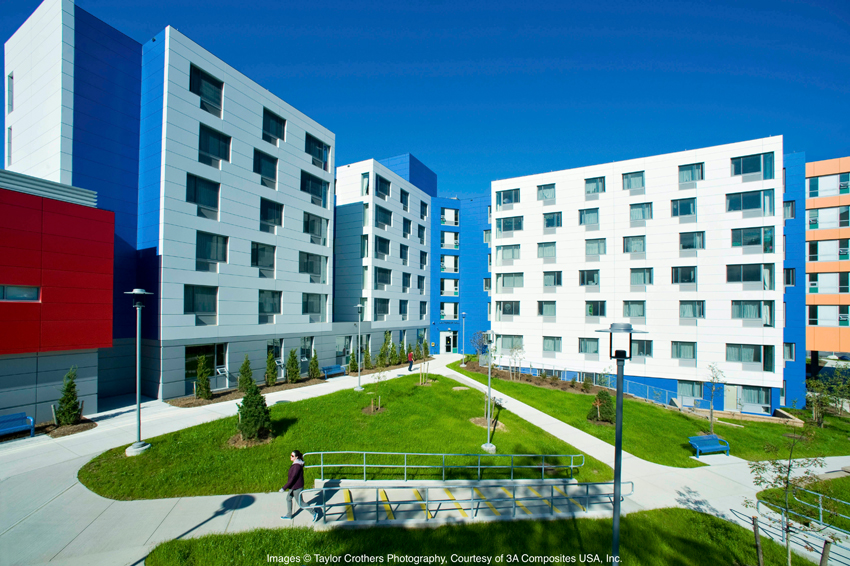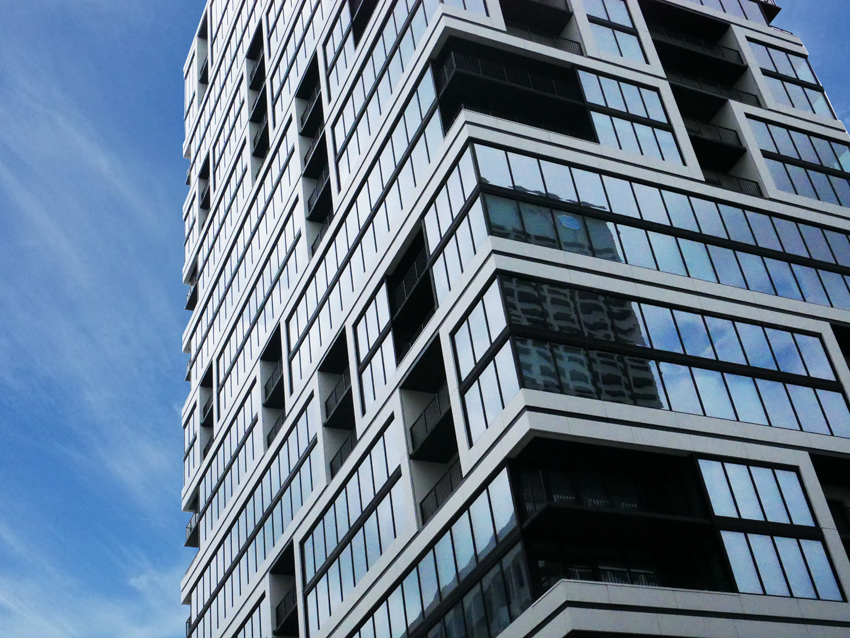
Photo courtesy of Taylor Crothers/3A Composites USA
Prefabricated aluminum composite material in bold colors deliver a striking facade at Stony Brook University’s Nobel Halls in Stony Brook, N.Y.
Engineering Analysis
With the combinations of components and materials making up a wall assembly numbering in the thousands, it is literally impossible to test every single assembly. Furthermore, building teams may have a need to change one of the materials in an already-tested assembly. Consequently, Engineering Judgements (EJ), also called Engineering Evaluations, can be performed in lieu of NFPA 285 testing.
“Engineering Judgements are a fantastic tool to gain minor variations in an NFPA 285-compliant assembly and still comply with the intent of the building code,” states Nelson. “Any deviation from the tested assembly in the materials used, their configuration, how the materials are attached, the size of the air space, no longer comply with NFPA 285. An EJ will allow a project team to swap out the WRB, insulation, or other materials of the assembly, provided that the rest of the assembly remains the same and is subjected to small-scale testing to demonstrate that the new material does not contribute to fire propagation more than the original material.”
IBC Section 104.11 allows EJ submittal where the AHJ can consider alternate materials, designs or methods of construction.
Performed by a qualified professional, the EJ analyzes the proposed assembly with the expectation that it will meet fire protection standards based upon the following:
- Previous successful NFPA 285 tests of "similar" wall assemblies
- Additional material tests such as the cone calorimeter test, which provides ignition and heat-release rate information for various materials
- Previous experience in the testing of wall assemblies to NFPA 285.
“The Engineering Judgment should use engineering principles, such as heat transfer, to evaluate the difference in order to render an engineering opinion regarding the performance of the non-tested assembly,” explains Grill.
Often, EJs are provided in the form of an engineering analysis table/product specific evaluation that presents a menu of different components (i.e., a listing of different weather barriers, exterior insulation types, air cavity depths, and cladding materials) that, in combination, could be used to create a “fire-protection friendly” wall assembly. Regarding the air cavity, the EJ can only allow a depth equal to, or less than, that which was tested.
While these analyses present the information to determine the acceptability of a wall assembly, it is ultimately up to the AHJ to review the evaluation and rule on acceptability.
Experts recommend starting the process in the early stages of design, with a list of the proposed exterior wall materials and wall cross-sections. The team should also reach out to manufacturers for their NFPA 285 history and compare this list with the proposed wall assembly.
Another variable driving interest in EJs is the fact that NFPA 285 wall assembly tests cost an average of $35,000 to $40,000 and take two to four months of planning, product inspections, fabrication, and assembly. The manufacturer also takes responsibility for shipping the material to the lab, preparing the drawings for the test specimen, and having the assembly installed. Furthermore, the test itself, the report, and the disposal, must all be paid for.
While manufacturers must pay an engineer to perform an EJ, and there’s no guarantee that the AHJ will ultimately accept the assembly, it can be a more viable option, particularly when a building is already under construction and there simply isn’t time to organize and perform the NFPA 285 test.

Photo courtesy of MillerClapperton
Metal composite material helps create the l’s and i’s of the lilli Midtown high-end apartment tower in Atlanta.
As Intended
Once an assembly passes the NFPA 285-19 test, and it comes time to install the wall, Schultz stresses the importance of verifying that the products ordered match the products in the approved design and that the assemblies are installed in the same way as they were tested. This includes specifications like stud spacing, fastener lengths, and air gap dimensions.
In review, U.S. building codes have been incorporating multistory fire testing since the 1980s. The development and IBC adoption of NFPA 285 provides life safety for buildings and is required for wall assemblies containing combustible components—weather-resistant barriers, insulation, and cladding—in Building Types I-IV. With changes made to NFPA 285-19, the life safety of wall assemblies has been further enhanced.
It should be emphasized that NFPA 285 is a wall assembly test, not a material test. In lieu of NFPA 285 testing, engineering analyses based upon manufacturers' tests can provide specifiers with more NFPA 285-compliant options for wall assemblies. As noted, a key NFPA 285-19-friendly option for architects are MCM panels with an FR core, as they contain fire-retardant chemicals that limit the amount of available fuel and potential for flame spread.
As more MCM systems are tested against–and meet–the stricter NFPA 285-19 standards, engineers anticipate that this will spur a rise in demand for this cladding option as a solid and safe choice.
Barbara Horwitz-Bennett is a veteran architectural journalist who has written hundreds of CEUs and articles for various AEC publications.BHBennett.com
